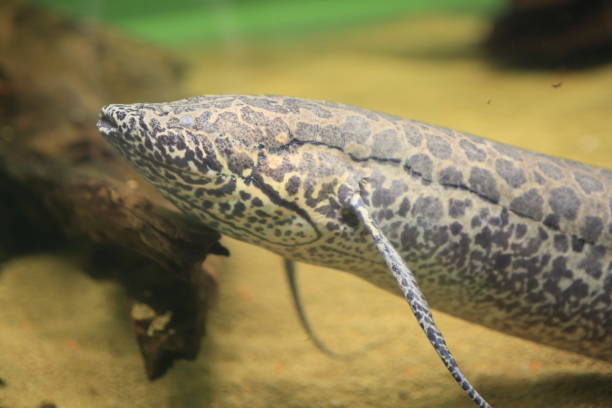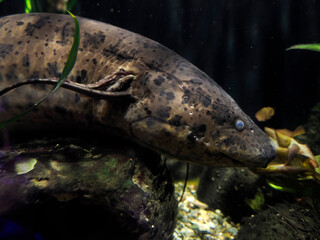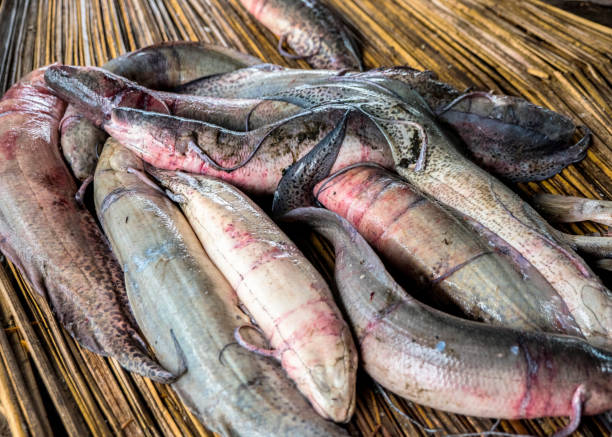Table of Contents
Scientific Classification
| Kingdom | Animalia |
| Phylum | Chordata |
| Class | Sarcopterygii |
| Order | Lepidosireniformes |
| Family | Protopteridae |
| Genus | Protopterus |
| Species | Multiple species |
| Scientific Name | Protopterus spp |
Description
The African lungfish (Protopterus spp.) is a remarkable and ancient species that has intrigued scientists for many years. Lungfish have long, eel-like bodies and can reach lengths of 1 to 2 meters (3 to 6 feet), depending on the species. They possess paired pectoral and pelvic fins, which they use to glide slowly and carefully along the bottom of their aquatic environments. Unlike most fish, their gills are underdeveloped, and they primarily rely on lung-like structures to breathe atmospheric oxygen, allowing them to thrive in waters with low oxygen levels.
Their skin is covered in mucus-coated scales that help retain moisture and provide protection against predators. These scales can appear grayish-brown or olive-green, enabling them to blend seamlessly into muddy waters and murky habitats.

Distribution
African lungfish inhabit freshwater environments throughout sub-Saharan Africa. They are commonly located in seasonal floodplains, swamps, rivers, and lakes where water levels fluctuate.
Habitat
African lungfish like slow-moving or still freshwater. They thrive in muddy bottoms and dense plants. They thrive in low oxygen areas. Most fish species cannot live there. In the dry season, water sources shrink or dry up. Lungfish then burrow into the mud and enter aestivation. This is a type of hibernation that can last from several months to years.
Diet
Lungfish are opportunistic carnivores, feeding on a wide range of prey, including:
- Small fish
- Insects and larvae
- Crustaceans
- Amphibians
- Mollusks
- Detritus and decaying matter
Some species also scavenge on dead animals, making them essential for ecosystem balance.

Behavior
African lungfish display intriguing behaviors that showcase their adaptability:
Nocturnal hunters, they are active at night and rely on their keen sense of smell to locate prey in the dark waters.
Air-breathing: Unlike most fish, these creatures surface for air, a behavior typical in environments with low oxygen levels.
Burrowing: When water levels drop, lungfish create a mucus cocoon and burrow into the mud, allowing them to survive for months without water by significantly slowing their metabolism.
Solitary nature: Generally, they prefer solitude, except during breeding seasons.
Lifespan
African lungfish are known for their longevity, typically living 20 to 30 years in the wild. In captivity, they can reach ages of up to 50 years, making them among the longest-living freshwater fish.

Reproduction and Lifecycle
Lungfish usually reproduce in the rainy season. During this time, water levels rise. This creates the perfect conditions for breeding.
- Males build nests in shallow waters or muddy burrows.
- Females lay hundreds of eggs, which hatch within a few days.
- Parental care: Males guard the nest and aerate the water to ensure the survival of the hatchlings.
- Larvae resemble amphibians, possessing external gills before transitioning to lung-dependent respiration.
- Young lungfish grow rapidly, reaching maturity within a few years.
Predators
Adult African lungfish have few natural predators. Their size and ability to burrow help them avoid danger. However, young lungfish are preyed upon by:
- Birds (herons, storks)
- Larger fish (catfish, pike)
- Crocodiles
- Humans (for food and the pet trade)

Adaptations
- The African lungfish has evolved remarkable adaptations to thrive in challenging environments:
- Lungs for air breathing: Crucial for survival in waters with low oxygen levels and during dry spells.
- Aestivation: This ability enables the lungfish to enter a sleep-like state when water is scarce, allowing it to survive for years without food or water.
- Mucus cocoon: This layer helps prevent dehydration while the fish is dormant.
- Flexible diet: It can eat a wide range of prey, which helps minimize competition.
- Burrowing behavior: This instinct offers protection from predators and extreme changes in the environment.
Conservation Status
The conservation status of African lungfish differs by species. The International Union for Conservation of Nature (IUCN) classifies them as Least Concern (LC). However, some localized populations are threatened due to:
Threats:
- Habitat destruction: Draining of wetlands, deforestation, and dam construction disrupt their natural environment.
- Overfishing: In some areas, lungfish are caught for food and the exotic pet trade.
- Pollution: Agricultural runoff and industrial waste contaminate freshwater systems.
- Climate change: Altered rainfall patterns affect their breeding and aestivation cycles.
Conservation Efforts:
- Wetland conservation programs: Safeguarding and revitalizing essential habitats.
- Sustainable fishing practices: Managing overfishing and combating illegal trade.
- Research and awareness campaigns: Raising awareness about the ecological significance of the species.
Conclusion
The African lungfish is often referred to as a living fossil, representing an ancient lineage of fish. These remarkable creatures have withstood significant environmental changes over millions of years. Their unique ability to breathe air and hibernate for extended periods sets them apart. Additionally, they can adapt to challenging conditions in the animal kingdom. Unfortunately, human activities are threatening freshwater ecosystems. It is crucial that we prioritize conservation efforts to ensure this incredible survivor continues to thrive for future generations.



